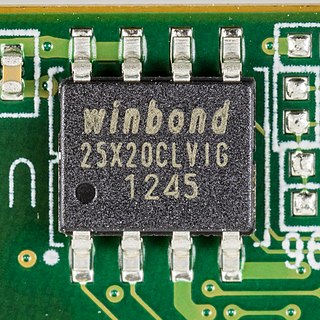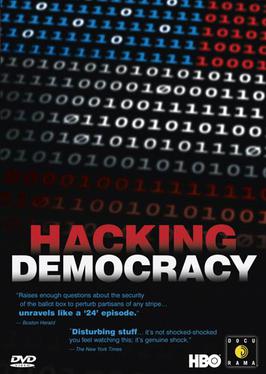
In computing, firmware is software that provides low-level control of computing device hardware. For a relatively simple device, firmware may perform all control, monitoring and data manipulation functionality. For a more complex device, firmware may provide relatively low-level control as well as hardware abstraction services to higher-level software such as an operating system.
A ballot is a device used to cast votes in an election and may be found as a piece of paper or a small ball used in voting. It was originally a small ball used to record decisions made by voters in Italy around the 16th century.
Premier Election Solutions, formerly Diebold Election Systems, Inc. (DESI), was a subsidiary of Diebold that made and sold voting machines.
A voting machine is a machine used to record votes in an election without paper. The first voting machines were mechanical but it is increasingly more common to use electronic voting machines. Traditionally, a voting machine has been defined by its mechanism, and whether the system tallies votes at each voting location, or centrally. Voting machines should not be confused with tabulating machines, which count votes done by paper ballot.
Electronic voting is voting that uses electronic means to either aid or take care of casting and counting ballots including voting time.
Bev Harris is an American writer, activist, and founder of Black Box Voting, a national, nonpartisan elections watchdog group. She helped popularize the term "black box voting", while authoring a book of that title.

Kevin Francis Shelley is an American politician, who was the 28th California Secretary of State from January 6, 2003, until his resignation on March 4, 2005.
An electronic voting machine is a voting machine based on electronics. Two main technologies exist: optical scanning and direct recording (DRE).
Voter verifiable paper audit trail (VVPAT) or verified paper record (VPR) is a method of providing feedback to voters who use an electronic voting system. A VVPAT allows voters to verify that their vote was cast correctly, to detect possible election fraud or malfunction, and to provide a means to audit the stored electronic results. It contains the name and party affiliation of candidates for whom the vote has been cast. While VVPAT has gained in use in the United States compared with ballotless voting systems without it, hand-marked ballots are used by a greater proportion of jurisdictions.
A DRE voting machine, or direct-recording electronic voting machine, records votes by means of a ballot display provided with mechanical or electro-optical components that can be activated by the voter. These are typically buttons or a touchscreen; and they process data using a computer program to record voting data and ballot images in memory components. After the election, it produces a tabulation of the voting data stored in a removable memory component and as printed copy. The system may also provide a means for transmitting individual ballots or vote totals to a central location for consolidating and reporting results from precincts at the central location. The device started to be massively used in 1996 in Brazil where 100% of the elections voting system is carried out using machines.
The Open Voting Consortium (OVC) is a non-profit advocacy group dedicated to the development, maintenance, and delivery of trustable and open voting systems for use in public elections.

Hacking Democracy is a 2006 Emmy nominated documentary film broadcast on HBO and created by producer / directors Russell Michaels and Simon Ardizzone, with producer Robert Carrillo Cohen, and executive producers Sarah Teale, Sian Edwards & Earl Katz. Filmed over three years it documents American citizens investigating anomalies and irregularities with electronic voting systems that occurred during the 2000 and 2004 elections in the United States, especially in Volusia County, Florida. The film investigates the flawed integrity of electronic voting machines, particularly those made by Diebold Election Systems, exposing previously unknown backdoors in the Diebold trade secret computer software. The film culminates dramatically in the on-camera hacking of the in-use / working Diebold election system in Leon County, Florida - the same computer voting system which has been used in actual American elections across thirty-three states, and which still counts tens of millions of America's votes today.
End-to-end auditable or end-to-end voter verifiable (E2E) systems are voting systems with stringent integrity properties and strong tamper resistance. E2E systems use cryptographic techniques to provide voters with receipts that allow them to verify their votes were counted as cast, without revealing which candidates a voter supported to an external party. As such, these systems are sometimes called receipt-based systems.
An optical scan voting system is an electronic voting system and uses an optical scanner to read marked paper ballots and tally the results.
The Hursti Hack was a successful attempt to alter the votes recorded on a Diebold optical scan voting machine. The hack is named after Harri Hursti.
An electronic pollbook, also known as an e-pollbook, is typically either hardware, software or a combination of the two that allows election officials to review and/or maintain voter register information for an election, but does not actually count votes. This software or hardware is used in place of paper-based pollbooks, which are typically three-ring binders. Often, the functions of an e-pollbook include voter lookup, verification, identification, precinct assignment, ballot assignment, voter history update and other functions such as name change, address change and/or redirecting voters to correct voting location.

Electronic voting was first introduced to Brazil in 1996, with the first tests carried out in the state of Santa Catarina. The primary design goal of the voting machine is extreme simplicity, the model being a public phone booth. The voting machines perform three steps – voter identification, secure voting, and tallying – in a single process, aiming to eliminate fraud based on forged or falsified public documents. Political parties have access to the voting machine's programs before the election for auditing.
A ballot marking device (BMD) or vote recorder is a type of voting machine used by voters to record votes on physical ballots. In general, ballot marking devices neither store nor tabulate ballots, but only allow the voter to record votes on ballots that are then stored and tabulated elsewhere.

Electronic voting in the United States involves several types of machines: touchscreens for voters to mark choices, scanners to read paper ballots, scanners to verify signatures on envelopes of absentee ballots, and web servers to display tallies to the public. Aside from voting, there are also computer systems to maintain voter registrations and display these electoral rolls to polling place staff.
Aggelos Kiayias is a Greek cryptographer and computer scientist, currently a professor at the University of Edinburgh and the Chief Science Officer at Input Output Global, the company behind Cardano.




